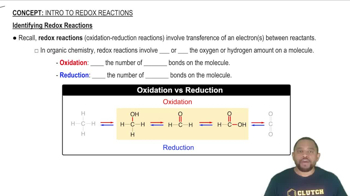Here are the essential concepts you must grasp in order to answer the question correctly.
Standard Electrode Potential (E°)
The standard electrode potential (E°) is a measure of the tendency of a chemical species to be reduced, expressed in volts. It is determined under standard conditions (1 M concentration, 1 atm pressure, and 25°C). A positive E° indicates a greater likelihood of reduction, while a negative E° suggests a lesser tendency. This concept is crucial for understanding redox reactions and calculating the overall cell potential.
Recommended video:
Gibbs Free Energy (∆G°)
Gibbs free energy (∆G°) is a thermodynamic quantity that indicates the spontaneity of a reaction at standard conditions. A negative ∆G° value signifies that a reaction can occur spontaneously, while a positive value indicates non-spontaneity. The relationship between E° and ∆G° is given by the equation ∆G° = -nFE°, where n is the number of moles of electrons transferred and F is Faraday's constant. Understanding this relationship is essential for predicting reaction feasibility.
Recommended video:
Gibbs Free Energy of Reactions
Redox Reactions
Redox reactions involve the transfer of electrons between two species, where one is oxidized (loses electrons) and the other is reduced (gains electrons). In the context of the reaction between hydrochloric acid and potassium permanganate, identifying the oxidation states of the elements involved helps determine which species undergoes oxidation and which undergoes reduction. Mastery of redox concepts is vital for calculating E° and ∆G° accurately.
Recommended video:
Identifying Redox Reactions
 Verified step by step guidance
Verified step by step guidance


